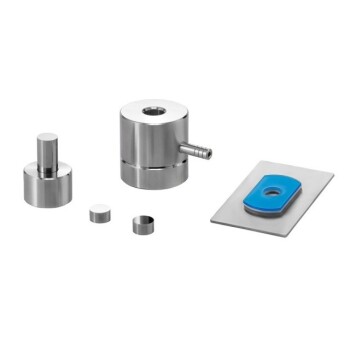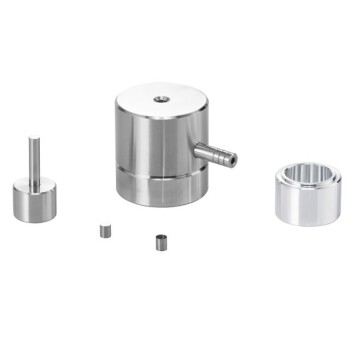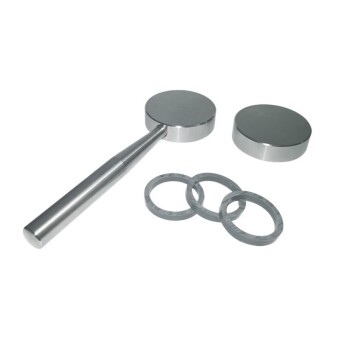Pressed pellets are a standard in XRF analysis because they provide a rapid, cost-effective method for creating a uniform sample essential for accurate results. This technique transforms a powdered sample into a dense, solid disc with a perfectly flat surface, which directly addresses the physical requirements for reliable X-ray fluorescence measurement.
The core challenge in XRF is presenting a perfectly flat, dense, and homogeneous sample to the instrument's X-ray beam. Pressed pellets achieve an excellent balance of these ideal characteristics, providing high-quality data without the significant cost and complexity of more advanced fusion methods.
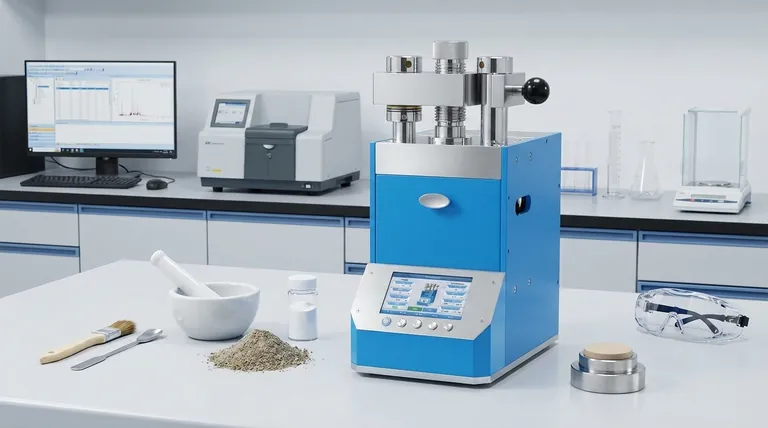
The Core Problem: Why Raw Samples Give Poor Results
Before understanding the benefits of pellets, it is crucial to recognize the inherent flaws of analyzing unprepared samples like loose powders. The accuracy of XRF is fundamentally tied to the physical nature of the sample surface.
The Particle Size Effect
In a powder with varying particle sizes, the X-ray beam can interact disproportionately with larger particles. This "shadowing" effect means the measured fluorescence may over-represent some elements and under-represent others, leading to significant analytical error.
The Density and Void Space Problem
Loose powders are filled with air gaps, or void spaces. Because the X-ray beam interacts with less material per unit area, the resulting signal intensity is lower and more variable. This weakens the instrument's sensitivity, especially for trace elements.
The Homogeneity Challenge
Within a sample container, fine and coarse particles can segregate due to vibration or settling. This means the surface layer analyzed by the XRF instrument may not be a true representation of the bulk sample's composition, compromising the accuracy of the result.
How Pressed Pellets Create an Ideal Sample
The process of grinding a sample into a fine powder and compressing it under high pressure systematically solves the problems associated with raw samples.
Creating a Uniform, Dense Surface
A hydraulic press compacts the powder, eliminating the air voids between particles. This creates a solid, highly dense pellet with a smooth, flat surface that is ideal for XRF analysis, leading to higher signal intensities and improved sensitivity.
Mitigating Particle Size Effects
The first step is always to grind the sample to a very fine, consistent particle size, typically below 50 micrometers. Pressing this fine powder then locks the particles into a fixed matrix, ensuring the X-ray beam interacts with a consistent and representative average of the sample's composition.
Ensuring Homogeneity and Stability
The act of pressing the powder into a solid disc creates a homogeneous and durable sample. These pellets are stable, easy to handle, can be labeled for archival purposes, and can be re-analyzed later with high repeatability.
The Role of Binders
For brittle materials like geological minerals that do not bind well under pressure, a small amount of binding agent (like cellulose or boric acid) is mixed in. This improves particle adhesion and creates a more durable and robust pellet.
Understanding the Trade-offs: Pellets vs. Fused Beads
Pressed pellets are not the only method of sample preparation. It is critical to understand their place relative to the "gold standard" of XRF: fused beads.
The Case for Pressed Pellets: Speed and Cost
Pellets are the go-to method for high-throughput environments. Preparation is fast, equipment costs (a grinder and a press) are relatively low, and consumable costs are minimal. This makes it an extremely efficient choice for process control and routine analysis.
The Limitations of Pellets
Even with fine grinding, some minor residual particle effects can remain. Furthermore, the use of a binding agent introduces a small amount of dilution, which must be accounted for in the calibration. For the absolute highest accuracy, these factors can be a limitation.
When to Choose Fused Beads: Ultimate Accuracy
For applications demanding the highest possible precision, such as in geochemistry or for certified reference materials, fused beads are superior. This method involves dissolving the sample in a molten lithium borate flux, which creates a perfectly homogeneous glass disc. This completely eliminates all particle size and mineralogical effects but is significantly more expensive, slower, and requires high-temperature fusion equipment.
Making the Right Choice for Your Goal
The best preparation method depends entirely on your specific analytical requirements for speed, cost, and accuracy.
- If your primary focus is high-throughput screening or process control: Pressed pellets are the ideal choice, offering a rapid and cost-effective balance of speed and sufficient accuracy.
- If your primary focus is analyzing trace elements at very low levels or meeting strict certification standards: You should strongly consider fused beads, as they eliminate matrix effects and provide the highest level of accuracy and precision.
- If your primary focus is simple qualitative identification (e.g., checking for the presence of lead): Analyzing unprepared loose powder may be sufficient, but a pressed pellet will always provide more consistent and reliable data.
Ultimately, understanding how sample preparation directly impacts your data is the key to generating trustworthy and defensible XRF results.
Summary Table:
| Aspect | Description |
|---|---|
| Uniformity | Creates a flat, homogeneous surface for consistent X-ray interaction. |
| Density | Eliminates air gaps, enhancing signal intensity and sensitivity. |
| Cost-Effectiveness | Low equipment and consumable costs, ideal for high-throughput labs. |
| Speed | Rapid preparation compared to fused beads, boosting productivity. |
| Stability | Durable pellets allow for easy handling, labeling, and re-analysis. |
Upgrade your lab's efficiency with KINTEK's precision lab press machines! Whether you need automatic, isostatic, or heated lab presses, our equipment is designed to deliver uniform, high-quality pressed pellets for accurate XRF analysis. Serving laboratories worldwide, we help you achieve reliable results faster and at lower costs. Contact us today to discuss your specific needs and discover how our solutions can enhance your sample preparation process!
Visual Guide
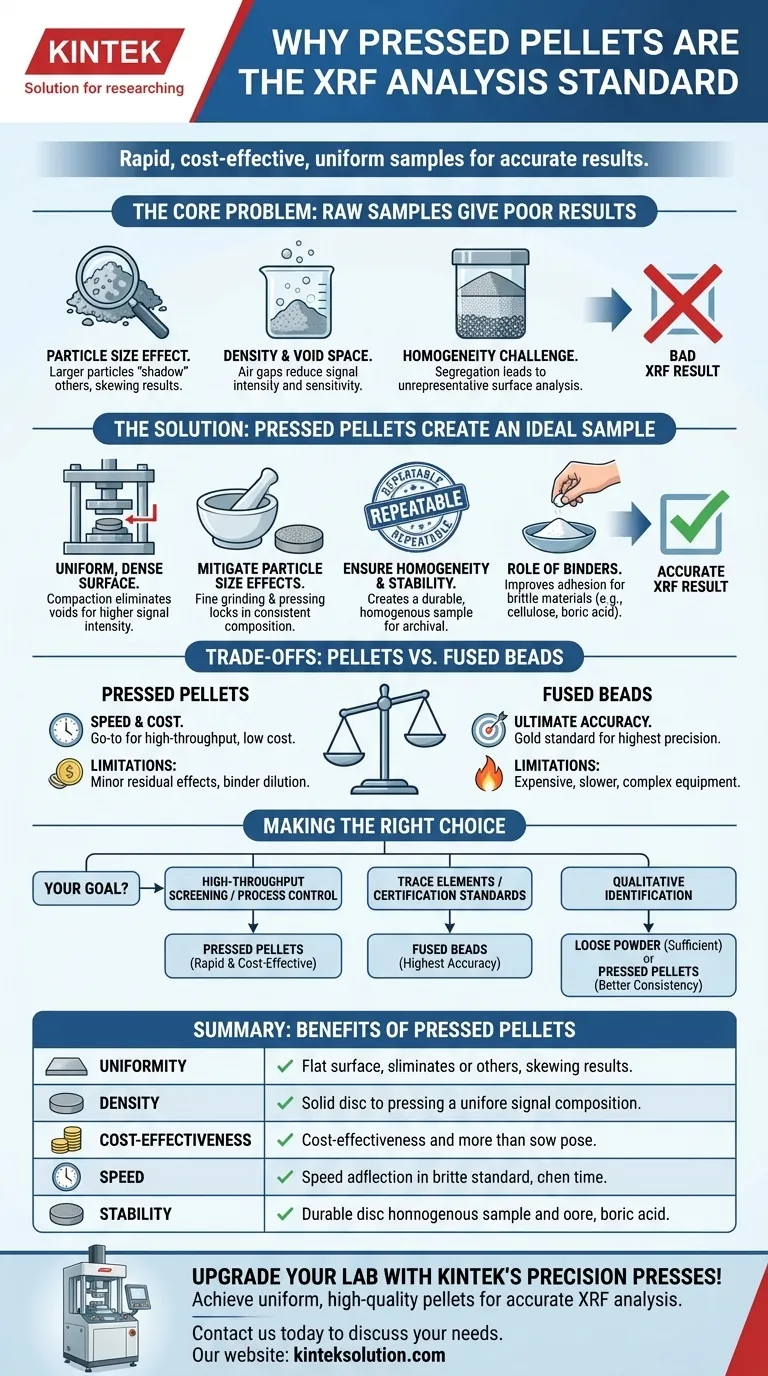
Related Products
- Automatic Laboratory Hydraulic Press for XRF and KBR Pellet Pressing
- Automatic Laboratory Hydraulic Press Lab Pellet Press Machine
- Laboratory Hydraulic Press 2T Lab Pellet Press for KBR FTIR
- Laboratory Hydraulic Pellet Press for XRF KBR FTIR Lab Press
- Manual Laboratory Hydraulic Press Lab Pellet Press
People Also Ask
- How do pressed pellets compare to other sample preparation methods for XRF analysis? Boost Accuracy and Efficiency in Your Lab
- What is the purpose of creating pellets for XRF spectroscopy using a hydraulic press? Ensure Accurate and Repeatable Elemental Analysis
- Why is a hydraulic press important for FTIR spectroscopy? Ensure Accurate Sample Analysis with KBr Pellets
- What safety features are associated with hydraulic presses in laboratories? Ensure Operator and Equipment Protection
- How are hydraulic presses used in laboratory sample preparation? Ensure Accurate Analysis with Homogeneous Samples








